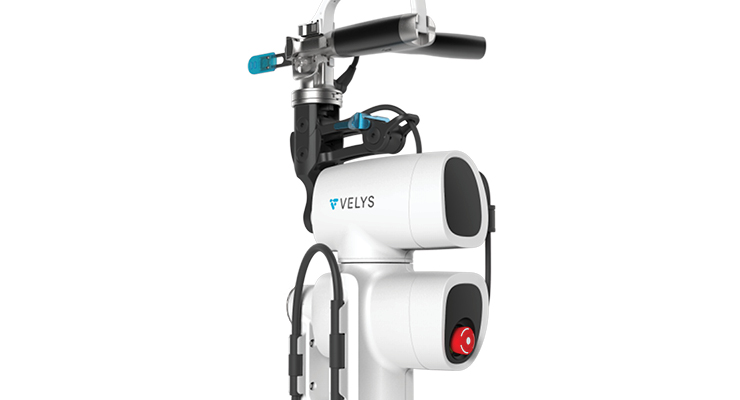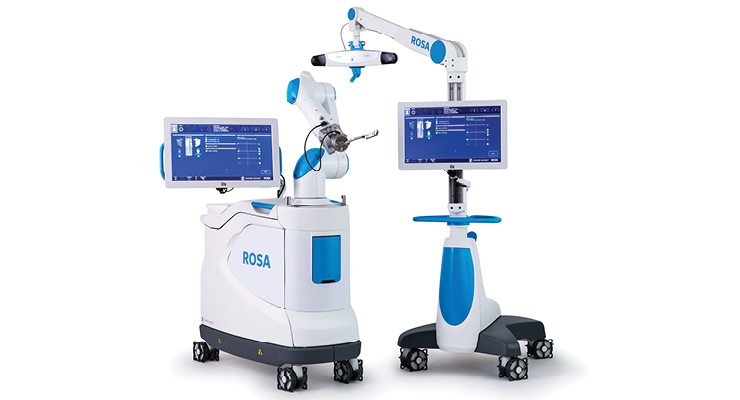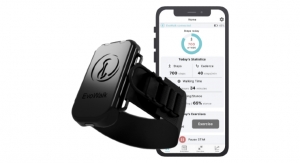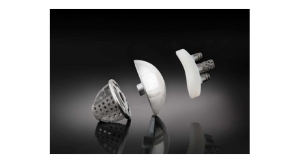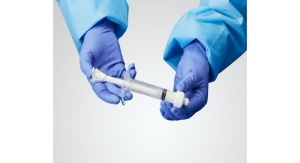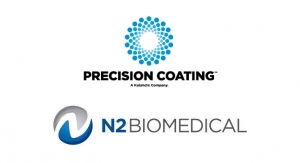Sam Brusco, Associate Editor03.16.21
According to Persistence Market Research, the orthopedic robotics surgical market reached a valuation of about $1 billion in 2018. The firm predicts that market will expand to account for over $4.1 billion by the end of 2029. Increasing emphasis on value-based outcomes and reduced cost of hospital stays continue to propel the market. The desire to automate also exists for both medical manufacturing and clinical applications. Orthopedic surgical robots fulfill this need while performing surgery.
Further, rising cases of ailments like meniscus tears, ligament ruptures, knee and hip fractures, rheumatoid arthritis, and osteoarthritis continue to fuel the need for robotic or computer-assisted surgical solutions.
“Orthopedic robotics have reached an inflection point in the adoption curve and are here to stay,” commented Elise Wolf, GM of digital surgery and robotics and VP of quality control for SmartTRAK, an Irvine, Calif.-based medical device business intelligence solution that networks an entire organization with real-time market data and analysis. “Orthopedic and spinal implant companies with robotic systems have achieved above-market growth assisted by implant pull-through associated with the robot.”
The SARS-CoV-2 pandemic stifled pretty much every medtech sector to some degree, with the exception of diagnostic tests, ventilator technologies, and personal protective equipment. Orthopedics was hit hardest because the sector is largely comprised of elective surgeries. Global orthopedic firms saw revenue loss percentages in the double-digits in 2020: Zimmer Biomet and Smith+Nephew dropped 12 percent from the previous year, and NuVasive fell 10 percent. According to Research and Markets, about 28 million surgeries were called off around the world during the pandemic’s duration thus far. Accordingly, the procedural decline led to deterioration in surgical robotics sales.
“Robot placements across orthopedics and spine were achieving record placements prior to COVID-19,” said Wolf. “As more lucrative elective recon and spine procedures were postponed due to the pandemic, hospitals faced significant budget constraints limiting capital equipment (robotic and navigation) sales. The most successful companies have adapted their business models to place systems in exchange for long-term minimum implant commitments. Based on Q4 2020 earnings calls, companies have seen a promising procedural resurgence and a swing back to more hospital capital equipment sales.”
There is indeed hope for the sector to reignite. A global decline in COVID-19 cases, decreasing virus-related hospitalizations, and acceleration of the vaccine rollout have given much-needed optimism. According to Medtronic CFO Karen Parkhill, more hospitals invested in capital equipment, and the firm achieved record numbers of Mazor robot sales in its Q3 fiscal year 2021, and near-record sales of navigation and O-arm imaging systems. “At this stage, our capital sales are, at least last quarter, back up to pre-COVID levels,” Parkhill said in a Cowen Healthcare conference call. “While we think one quarter is not necessarily a trend yet, we’re encouraged by what we saw.”
The orthopedic robotic industry slowly resuming its speedy pace is excellent news for the orthopedic community for myriad reasons. Chief among these is the potential savings for patients and hospitals.
“Opportunities include reduced patient hospital stays, and thus for the payer,” said Mitch Foster, CEO of Mindset Medical, a Pheonix, Ariz.-based developer of a digital health platform built to efficiently and effectively turn data into clinical information for physicians. “The financial impact of that includes contracting changes, bundled payments, and outcome driven reimbursement.”
Other benefits of using robotics to assist in orthopedic surgeries include a shortening of the adoption curve for minimally invasive surgery, reduced tissue disruption, less hospital stay-related complications, and simplification of more complex surgeries.
“Reduced imaging/exposure as well as robotic and imaging synergy are further opportunities—we could potentially see new technology on the intra-op imaging like ultrasound,” said Foster. “One plus one should be five at some point along the continuum to drive OR efficiency and surgical throughput from a volume standpoint while improving the surgeon and patient experience.”
Despite the potential for reduced costs and improved outcomes, there are still challenges hampering opportunities for adoption of orthopedic surgical robots. Lack of skillsets among orthopedic surgeons can be limiting, as can high costs associated with the advanced technology—particularly in middle- and low-income countries.
“Key challenges continue to include capital equipment’s high cost and companies able to be nimble in their business models will be most likely to succeed,” advised Wolf. “In addition, while clinical data shows enabling technologies increase implant alignment’s accuracy, the key is translation into improved clinical outcomes.”
“Today’s robotic solutions are complex,” Sharrolyn Josse, worldwide president of VELYS Digital Surgery at global orthopedic manufacturer DePuy Synthes, told ODT. “They could add OR time, reduce efficiencies, are large, cumbersome, and may also add cost to serve for the hospital.”
On Bended Knee
Industry data shows that up to 20 percent1,2 of knee replacement patients aren’t satisfied with their surgery’s outcome. The process of selection can be quite subjective—there are limited options for surgical planning personalization and post-operative rehab, and data collection isn’t connected across the continuum of care. The volume of joint replacement surgeries is ballooning, and surgeons are taking on more cases than ever before. This puts enormous physical and mental strain on them as they face scrutiny on outcomes and the need to reduce costs. Greater efficiency, precision, and reproducibility is needed to reconcile the increased volume of joint replacements.
Orthopedic giant DePuy Synthes achieved FDA clearance for the VELYS Robotic-Assisted Solution—the latest to its VELYS Digital Surgery Platform—for use with its Attune total knee in January. VELYS Digital Surgery, according to the company, is a platform of connected technologies powered by data insights before, during, and after orthopedic surgery to elevate the care experience.
“We’ve moved to the next generation of robotic solutions in orthopedics to address future market needs, including reduced complexity, reduced operating room time, and rapid operating room turnover,” said Josse. “This provides a more efficient learning curve with a smaller footprint to serve both ambulatory surgery centers (ASCs) and specialty hospital settings.”
Acting as an extension of the surgeon, DePuy intends for the robotic-assisted solution to reduce procedure times, simplify the user (surgeon) experience, and reduce costs for healthcare systems compared to competitive technologies.
“The VELYS Robotic-Assisted Solution is a first-of-its-kind table mounted solution, with an efficient design that integrates into any OR,” said Josse. “The system adapts to the surgeon’s workflow and is designed to give them the control they are used to and helps them execute accurate bony cuts.3 It utilizes advanced planning capabilities, proprietary technology, and a next-generation design to help surgeons accurately resect bones that align and position the implant relative to the soft tissue during total knee replacement without the need for pre-operative imaging.”
The robotic-assisted solution was designed from technology acquired from DePuy Synthes’ acquisition of software-enabled surgery technologies firm Orthotaxy in 2018. The company intends for VELYS Digital Surgery to be an evolving platform consisting of connected technologies to leverage data insights across the care continuum for end-to-end connectivity.
“With the VELYS Digital Surgery platform, we are taking bold steps to bring disruptive innovations to the market through a connected and personalized digital platform,” said Josse. “Although the VELYS Robotic-Assisted Solution is an important offering in the VELYS Digital Surgery Platform, our platform goes beyond robotics. It starts pre-operatively and continues after surgery through technologies that connect care teams with patients through action plans, education, direct feedback, and a companion mobile app designed for patients to access action plans and engage in direct support.”
For example, the company strives to use data and predictive analytics to identify risk specific to patients combined with care navigation to assure patient readiness for surgery, and optimal recovery following surgery. DePuy Synthes also partnered with innovative digital companies to develop cost-effective imaging that converts X-rays to 3D models in order to avoid unnecessary CT scan radiation exposure.
“Intraoperatively we envision a connected operating room that will include robotics and solutions focusing on digitized and synchronized workflows to target increased reproducibility, consistency, and efficiencies,” said Josse. “Post-operatively, we are working on integrating sensors for post-operative patient monitoring and rehabilitation.”
Worldwide orthopedic manufacturer Zimmer Biomet entered the surgical robotics market by acquiring its ROSA robot in 2016. The ROSA Knee system earned FDA clearance for robotically-assisted total knee replacement surgeries in January 2019. ROSA Knee features 3D pre-operative tools and real-time, intraoperative data on soft tissue and bone anatomy to improve bone cut accuracy and range of motion gap analysis to potentially boost flexion and restore national joint movement. According to Zimmer Biomet’s VP and worldwide GM of robotics Liane Teplitsky, over 200 ROSA Knee systems have been sold as of January.
Teplitsky recently interviewed with ODT editor-in-chief Sean Fenske for an episode of the publication’s “Medtech Matters” podcast where she provided background on drivers behind the robotic surgery movement, the latest with ROSA, and what’s ahead.
“I think we’ve brought objective measures into the OR,” Teplitsky said in the podcast. “This hasn’t been historically something surgeons have access to. We’re moving away from ‘feel’ and historical tribal knowledge, and enhancing the procedure with objective measures, which then can lead to data-driven decision making. Instead of a surgeon saying ‘a balanced knee feels like this’—which is obviously really hard to teach, train, and reproduce—we can now say ‘a balanced knee for an individual, if you move the knee this many degrees in this direction, and that many degrees in that direction, that’s the perfectly balanced knee.’”
ROSA Knee supports surgeons in performing total knee arthroplasty with features to assist with the bone resections, as well as evaluating the state of soft tissues to facilitate implant positioning intraoperatively. ROSA Knee currently supports the company’s Persona, Vanguard, and NexGen knee replacements. Dynamic tracking and real-time anatomy data helps surgeons achieve personalized care with better accuracy. Zimmer Biomet’s 2D X-ray to 3D bone modeling is also made possible based on the company’s proprietary X-Atlas technology.
“We have a proprietary 2D to 3D algorithm where you don’t need a pre-procedure CT,” explained Teplitsky. “So you can imagine, if you know the patient’s anatomy, and are using robotics, you can go in and pre-plan the case—what implant you think might work, what angles you want to be looking at—essentially doing a virtual surgery before the surgery.”
ROSA Knee was designed by surgeons, for surgeons as an accurate and efficient surgical assistant that also generates data. Surgeons are kept in the driver’s seat—they can maintain their current technique, approach, and philosophy to continue focusing on achieving optimal outcomes.
“It’s like putting a robot in the surgeon’s hands versus putting a surgeon in the robot’s hands,” Teplitsky said. “We specifically designed it to be surgeon-centric and make the transition from traditional instrumentation to robotic as straightforward as possible. The ROSA applications in general have been designed to work alongside the surgeon, while he or she leverages his or her preferential workflow.”
Clinical insights are offered throughout the episode of care. Zimmer Biomet’s OrthoIntel Orthopedic Intelligence Platform connects pre-, intra- and post-operative data gathered through its mymobility application and ROSA Knee. OrthoIntel consolidates intra-operative metrics gathered from ROSA Knee and mymobility on one dashboard. Those holistic metrics aim to increase visibility, reduce care variability, and help optimize outcomes.
Rise of the Machines
Once the pandemic subsides and orthopedic device business as usual can resume, the future of orthopedic robotic surgical systems is looking bright. In mid-February, the first minimally invasive spinal procedures were performed utilizing Medtronic’s newly cleared navigated disc prep, interbodies, and Midas Rex high speed drills with the Mazor Robotic Guidance System. According to the company, the initial cases demonstrated improved disc-prep access and interbody navigation, precise drilling, and predictable planning. Among the surgeries were an OLIF360sm single position surgery, an L2/3 decompression fusion and TLIF, and a minimally invasive TLIF with bilateral instrumentation using expandable interbody technology.
“Future applications [of robotic technology] could include automated accuracy to laminectomy using ultrasonic technology, a drill, or new ultrasonic bone cutting technology,” predicted Foster. “Robotic-assisted rod contouring and bending is another possibility.”
Intraoperative sensors may also be combined with robotic assisted technologies in the near future to provide even more data in the OR and after the procedure. For example, intraoperative sensors can boost the surgeon’s ability to achieve soft tissue balance during a total knee replacement. A number of studies have demonstrated that a balanced knee increases patient outcomes and satisfaction. Smart sensor technologies essentially transform surgical instruments into smart tools able to collect real-time, actionable data. Some believe that robotic sensor-assisted surgery will become the standard in total knee replacement.
“On the horizon are sensors and smart implants,” said Wolf. “Zimmer Biomet is expected to be the first company to offer a smart implant by developing Persona-IQ, a knee implant that incorporates Canary Medical sensor technology. Stryker is also interested in sensor technology, as evidenced by its recent acquisition of OrthoSensor. Smart implants and other technologies will enable companies to capture data through the entire continuum of care.”
The orthopedic surgical robots market landscape has been labeled as a “winner-takes-all” sector, where the orthopedic behemoths command 90 percent of the market value, according to Persistence Market Research. Firms at the sector’s forefront tout robust product portfolios, an impressive geographical presence, strong brand images, and constant investments in product developments and innovations. Conversely, small-scale and emerging manufacturers heavily rely on third-party distributors to push their products into the market. Companies in the orthopedic surgical robotics landscape must work on building strategies around ever-evolving clinical and patient needs to drive positive outcomes.
“Individual company success will rely on execution on a combined platform versus a stand-alone robotic application,” said Foster. “I think the robot married to an intra-op imaging and elegant approach, the instrumentation, the implant, and ease of use (UI/UX) will ultimately be the winning solution. Packaging the solution through procedures will also highly impact success—for example, a single position lateral procedure.”
With its goal to enable a more personalized care experience, greater insights for real-time decision making, and increased precision and consistency, DePuy Synthes’ VELYS Digital Surgery platform stands to make a significant impact on the market and for patient outcomes.
“We have received significant interest in the VELYS Robotic Assisted Solution,” said Josse. “Since receiving FDA 510(k) clearance, we have been training an initial list of customers and are working toward U.S. rollout in 2021, following commercial negotiations and installations.”
According to Johnson & Johnson’s executive VP and Worldwide Chairman of Medical Devices Ashley McEvoy’s statements during the Cowen 41st Annual Health Care Conference in March, VELYS is expected to be taken from knees into hips and other areas in orthopedics within three years.
“The VELYS Digital Surgery Platform is expanding beyond serving the joint reconstruction market and will include solutions to serve our trauma, sports and shoulders, and spine businesses,” said Josse.
McEvoy hinted at developments for hip surgery navigation during the conference call, citing “really good feedback on the combination of our ACTIS and clinical hips with the concise hammer with the VELYS hip navigation system.” She also spoke about collaboration with TINAVI in China and with Brainlab to address spinal surgery.
“We remain committed to personalized, connected care that enables surgeons and their patients to change their approach, reduce steps, improve outcomes, and increase patient satisfaction,” concluded Josse.
References
Further, rising cases of ailments like meniscus tears, ligament ruptures, knee and hip fractures, rheumatoid arthritis, and osteoarthritis continue to fuel the need for robotic or computer-assisted surgical solutions.
“Orthopedic robotics have reached an inflection point in the adoption curve and are here to stay,” commented Elise Wolf, GM of digital surgery and robotics and VP of quality control for SmartTRAK, an Irvine, Calif.-based medical device business intelligence solution that networks an entire organization with real-time market data and analysis. “Orthopedic and spinal implant companies with robotic systems have achieved above-market growth assisted by implant pull-through associated with the robot.”
The SARS-CoV-2 pandemic stifled pretty much every medtech sector to some degree, with the exception of diagnostic tests, ventilator technologies, and personal protective equipment. Orthopedics was hit hardest because the sector is largely comprised of elective surgeries. Global orthopedic firms saw revenue loss percentages in the double-digits in 2020: Zimmer Biomet and Smith+Nephew dropped 12 percent from the previous year, and NuVasive fell 10 percent. According to Research and Markets, about 28 million surgeries were called off around the world during the pandemic’s duration thus far. Accordingly, the procedural decline led to deterioration in surgical robotics sales.
“Robot placements across orthopedics and spine were achieving record placements prior to COVID-19,” said Wolf. “As more lucrative elective recon and spine procedures were postponed due to the pandemic, hospitals faced significant budget constraints limiting capital equipment (robotic and navigation) sales. The most successful companies have adapted their business models to place systems in exchange for long-term minimum implant commitments. Based on Q4 2020 earnings calls, companies have seen a promising procedural resurgence and a swing back to more hospital capital equipment sales.”
There is indeed hope for the sector to reignite. A global decline in COVID-19 cases, decreasing virus-related hospitalizations, and acceleration of the vaccine rollout have given much-needed optimism. According to Medtronic CFO Karen Parkhill, more hospitals invested in capital equipment, and the firm achieved record numbers of Mazor robot sales in its Q3 fiscal year 2021, and near-record sales of navigation and O-arm imaging systems. “At this stage, our capital sales are, at least last quarter, back up to pre-COVID levels,” Parkhill said in a Cowen Healthcare conference call. “While we think one quarter is not necessarily a trend yet, we’re encouraged by what we saw.”
The orthopedic robotic industry slowly resuming its speedy pace is excellent news for the orthopedic community for myriad reasons. Chief among these is the potential savings for patients and hospitals.
“Opportunities include reduced patient hospital stays, and thus for the payer,” said Mitch Foster, CEO of Mindset Medical, a Pheonix, Ariz.-based developer of a digital health platform built to efficiently and effectively turn data into clinical information for physicians. “The financial impact of that includes contracting changes, bundled payments, and outcome driven reimbursement.”
Other benefits of using robotics to assist in orthopedic surgeries include a shortening of the adoption curve for minimally invasive surgery, reduced tissue disruption, less hospital stay-related complications, and simplification of more complex surgeries.
“Reduced imaging/exposure as well as robotic and imaging synergy are further opportunities—we could potentially see new technology on the intra-op imaging like ultrasound,” said Foster. “One plus one should be five at some point along the continuum to drive OR efficiency and surgical throughput from a volume standpoint while improving the surgeon and patient experience.”
Despite the potential for reduced costs and improved outcomes, there are still challenges hampering opportunities for adoption of orthopedic surgical robots. Lack of skillsets among orthopedic surgeons can be limiting, as can high costs associated with the advanced technology—particularly in middle- and low-income countries.
“Key challenges continue to include capital equipment’s high cost and companies able to be nimble in their business models will be most likely to succeed,” advised Wolf. “In addition, while clinical data shows enabling technologies increase implant alignment’s accuracy, the key is translation into improved clinical outcomes.”
“Today’s robotic solutions are complex,” Sharrolyn Josse, worldwide president of VELYS Digital Surgery at global orthopedic manufacturer DePuy Synthes, told ODT. “They could add OR time, reduce efficiencies, are large, cumbersome, and may also add cost to serve for the hospital.”
On Bended Knee
Industry data shows that up to 20 percent1,2 of knee replacement patients aren’t satisfied with their surgery’s outcome. The process of selection can be quite subjective—there are limited options for surgical planning personalization and post-operative rehab, and data collection isn’t connected across the continuum of care. The volume of joint replacement surgeries is ballooning, and surgeons are taking on more cases than ever before. This puts enormous physical and mental strain on them as they face scrutiny on outcomes and the need to reduce costs. Greater efficiency, precision, and reproducibility is needed to reconcile the increased volume of joint replacements.
Orthopedic giant DePuy Synthes achieved FDA clearance for the VELYS Robotic-Assisted Solution—the latest to its VELYS Digital Surgery Platform—for use with its Attune total knee in January. VELYS Digital Surgery, according to the company, is a platform of connected technologies powered by data insights before, during, and after orthopedic surgery to elevate the care experience.
“We’ve moved to the next generation of robotic solutions in orthopedics to address future market needs, including reduced complexity, reduced operating room time, and rapid operating room turnover,” said Josse. “This provides a more efficient learning curve with a smaller footprint to serve both ambulatory surgery centers (ASCs) and specialty hospital settings.”
Acting as an extension of the surgeon, DePuy intends for the robotic-assisted solution to reduce procedure times, simplify the user (surgeon) experience, and reduce costs for healthcare systems compared to competitive technologies.
“The VELYS Robotic-Assisted Solution is a first-of-its-kind table mounted solution, with an efficient design that integrates into any OR,” said Josse. “The system adapts to the surgeon’s workflow and is designed to give them the control they are used to and helps them execute accurate bony cuts.3 It utilizes advanced planning capabilities, proprietary technology, and a next-generation design to help surgeons accurately resect bones that align and position the implant relative to the soft tissue during total knee replacement without the need for pre-operative imaging.”
The robotic-assisted solution was designed from technology acquired from DePuy Synthes’ acquisition of software-enabled surgery technologies firm Orthotaxy in 2018. The company intends for VELYS Digital Surgery to be an evolving platform consisting of connected technologies to leverage data insights across the care continuum for end-to-end connectivity.
“With the VELYS Digital Surgery platform, we are taking bold steps to bring disruptive innovations to the market through a connected and personalized digital platform,” said Josse. “Although the VELYS Robotic-Assisted Solution is an important offering in the VELYS Digital Surgery Platform, our platform goes beyond robotics. It starts pre-operatively and continues after surgery through technologies that connect care teams with patients through action plans, education, direct feedback, and a companion mobile app designed for patients to access action plans and engage in direct support.”
For example, the company strives to use data and predictive analytics to identify risk specific to patients combined with care navigation to assure patient readiness for surgery, and optimal recovery following surgery. DePuy Synthes also partnered with innovative digital companies to develop cost-effective imaging that converts X-rays to 3D models in order to avoid unnecessary CT scan radiation exposure.
“Intraoperatively we envision a connected operating room that will include robotics and solutions focusing on digitized and synchronized workflows to target increased reproducibility, consistency, and efficiencies,” said Josse. “Post-operatively, we are working on integrating sensors for post-operative patient monitoring and rehabilitation.”
Worldwide orthopedic manufacturer Zimmer Biomet entered the surgical robotics market by acquiring its ROSA robot in 2016. The ROSA Knee system earned FDA clearance for robotically-assisted total knee replacement surgeries in January 2019. ROSA Knee features 3D pre-operative tools and real-time, intraoperative data on soft tissue and bone anatomy to improve bone cut accuracy and range of motion gap analysis to potentially boost flexion and restore national joint movement. According to Zimmer Biomet’s VP and worldwide GM of robotics Liane Teplitsky, over 200 ROSA Knee systems have been sold as of January.
Teplitsky recently interviewed with ODT editor-in-chief Sean Fenske for an episode of the publication’s “Medtech Matters” podcast where she provided background on drivers behind the robotic surgery movement, the latest with ROSA, and what’s ahead.
“I think we’ve brought objective measures into the OR,” Teplitsky said in the podcast. “This hasn’t been historically something surgeons have access to. We’re moving away from ‘feel’ and historical tribal knowledge, and enhancing the procedure with objective measures, which then can lead to data-driven decision making. Instead of a surgeon saying ‘a balanced knee feels like this’—which is obviously really hard to teach, train, and reproduce—we can now say ‘a balanced knee for an individual, if you move the knee this many degrees in this direction, and that many degrees in that direction, that’s the perfectly balanced knee.’”
ROSA Knee supports surgeons in performing total knee arthroplasty with features to assist with the bone resections, as well as evaluating the state of soft tissues to facilitate implant positioning intraoperatively. ROSA Knee currently supports the company’s Persona, Vanguard, and NexGen knee replacements. Dynamic tracking and real-time anatomy data helps surgeons achieve personalized care with better accuracy. Zimmer Biomet’s 2D X-ray to 3D bone modeling is also made possible based on the company’s proprietary X-Atlas technology.
“We have a proprietary 2D to 3D algorithm where you don’t need a pre-procedure CT,” explained Teplitsky. “So you can imagine, if you know the patient’s anatomy, and are using robotics, you can go in and pre-plan the case—what implant you think might work, what angles you want to be looking at—essentially doing a virtual surgery before the surgery.”
ROSA Knee was designed by surgeons, for surgeons as an accurate and efficient surgical assistant that also generates data. Surgeons are kept in the driver’s seat—they can maintain their current technique, approach, and philosophy to continue focusing on achieving optimal outcomes.
“It’s like putting a robot in the surgeon’s hands versus putting a surgeon in the robot’s hands,” Teplitsky said. “We specifically designed it to be surgeon-centric and make the transition from traditional instrumentation to robotic as straightforward as possible. The ROSA applications in general have been designed to work alongside the surgeon, while he or she leverages his or her preferential workflow.”
Clinical insights are offered throughout the episode of care. Zimmer Biomet’s OrthoIntel Orthopedic Intelligence Platform connects pre-, intra- and post-operative data gathered through its mymobility application and ROSA Knee. OrthoIntel consolidates intra-operative metrics gathered from ROSA Knee and mymobility on one dashboard. Those holistic metrics aim to increase visibility, reduce care variability, and help optimize outcomes.
Rise of the Machines
Once the pandemic subsides and orthopedic device business as usual can resume, the future of orthopedic robotic surgical systems is looking bright. In mid-February, the first minimally invasive spinal procedures were performed utilizing Medtronic’s newly cleared navigated disc prep, interbodies, and Midas Rex high speed drills with the Mazor Robotic Guidance System. According to the company, the initial cases demonstrated improved disc-prep access and interbody navigation, precise drilling, and predictable planning. Among the surgeries were an OLIF360sm single position surgery, an L2/3 decompression fusion and TLIF, and a minimally invasive TLIF with bilateral instrumentation using expandable interbody technology.
“Future applications [of robotic technology] could include automated accuracy to laminectomy using ultrasonic technology, a drill, or new ultrasonic bone cutting technology,” predicted Foster. “Robotic-assisted rod contouring and bending is another possibility.”
Intraoperative sensors may also be combined with robotic assisted technologies in the near future to provide even more data in the OR and after the procedure. For example, intraoperative sensors can boost the surgeon’s ability to achieve soft tissue balance during a total knee replacement. A number of studies have demonstrated that a balanced knee increases patient outcomes and satisfaction. Smart sensor technologies essentially transform surgical instruments into smart tools able to collect real-time, actionable data. Some believe that robotic sensor-assisted surgery will become the standard in total knee replacement.
“On the horizon are sensors and smart implants,” said Wolf. “Zimmer Biomet is expected to be the first company to offer a smart implant by developing Persona-IQ, a knee implant that incorporates Canary Medical sensor technology. Stryker is also interested in sensor technology, as evidenced by its recent acquisition of OrthoSensor. Smart implants and other technologies will enable companies to capture data through the entire continuum of care.”
The orthopedic surgical robots market landscape has been labeled as a “winner-takes-all” sector, where the orthopedic behemoths command 90 percent of the market value, according to Persistence Market Research. Firms at the sector’s forefront tout robust product portfolios, an impressive geographical presence, strong brand images, and constant investments in product developments and innovations. Conversely, small-scale and emerging manufacturers heavily rely on third-party distributors to push their products into the market. Companies in the orthopedic surgical robotics landscape must work on building strategies around ever-evolving clinical and patient needs to drive positive outcomes.
“Individual company success will rely on execution on a combined platform versus a stand-alone robotic application,” said Foster. “I think the robot married to an intra-op imaging and elegant approach, the instrumentation, the implant, and ease of use (UI/UX) will ultimately be the winning solution. Packaging the solution through procedures will also highly impact success—for example, a single position lateral procedure.”
With its goal to enable a more personalized care experience, greater insights for real-time decision making, and increased precision and consistency, DePuy Synthes’ VELYS Digital Surgery platform stands to make a significant impact on the market and for patient outcomes.
“We have received significant interest in the VELYS Robotic Assisted Solution,” said Josse. “Since receiving FDA 510(k) clearance, we have been training an initial list of customers and are working toward U.S. rollout in 2021, following commercial negotiations and installations.”
According to Johnson & Johnson’s executive VP and Worldwide Chairman of Medical Devices Ashley McEvoy’s statements during the Cowen 41st Annual Health Care Conference in March, VELYS is expected to be taken from knees into hips and other areas in orthopedics within three years.
“The VELYS Digital Surgery Platform is expanding beyond serving the joint reconstruction market and will include solutions to serve our trauma, sports and shoulders, and spine businesses,” said Josse.
McEvoy hinted at developments for hip surgery navigation during the conference call, citing “really good feedback on the combination of our ACTIS and clinical hips with the concise hammer with the VELYS hip navigation system.” She also spoke about collaboration with TINAVI in China and with Brainlab to address spinal surgery.
“We remain committed to personalized, connected care that enables surgeons and their patients to change their approach, reduce steps, improve outcomes, and increase patient satisfaction,” concluded Josse.
|
Surgical robots are becoming very advanced, but there’s not yet need to worry about them locking surgeons out of the OR anytime soon. They aren’t operating independently. But what they are doing is increasingly helping surgeons operate more effectively. The robots endow their surgeon overlord with powers like a remote bionic arm or a superhuman eye. The current generation of robotic-assisted surgical technologies are highly specialized machines—but they’re still controlled by a highly skilled doctor. As such, surgeon operators should be heavily involved in the development of robotic-assisted technologies at every stage. An expensive piece of advanced capital equipment is an enormous waste of money without a trained surgeon—and robotic surgical training doesn’t come standard for an orthopedic surgeon (yet). So, to gain more insight into orthopedic surgeons’ experiences with robotic-assisted surgical technology, ODT spoke with Nathan Moore, D.O., an orthopedic surgeon at Phoenix Spine & Joint who specializes in hip and knee replacement. Which surgical procedures (or steps in surgical procedures) has robotic assistance most benefitted? Dr. Moore: Traditionally, we’ve taken a ’one size fits most’ approach to implant placement when using conventional instrumentation. Conventional instruments are designed to work well based on the ‘standard’ anatomy. This concept comes from anatomic studies used to determine a body part’s usual anatomic shape—which is accurate for about 70 percent of the population. So the conventional instruments used in most orthopedic procedures are designed to work well for about 70 percent of the patients. Precision of implant placement using conventional instrumentation has been proven to be inferior to surgery performed using robotic assistance. Advanced imaging and/or artificial intelligence to determine the patient’s actual anatomy is a further benefit. Pre-operative understanding of the patient’s actual anatomy is so beneficial for knowing the appropriate implant size, position, and type that would best suit the patient before we make a single incision. Knowing this before making any incision eliminates any need for cumbersome sizing guides and allows the ability to validate pre-operative planning decisions in real time. Intra operative validation of implant placement and positioning or validation of accurate bone prep is invaluable to joint replacement surgery. Robotics also lowers the risk of complications to surrounding soft tissue by placing boundaries on the surgical work. This almost completely eliminates the possibility of damaging local ligaments, blood vessels, and nerves. How steep is the learning curve for becoming skilled with robotic-assisted technologies? Dr. Moore: The learning curve is not very steep. I would say after five to 10 surgeries with the appropriate training foundation (i.e., a specific education course with certificate of training), one would easily be proficient in this type of surgery. What robotic surgical advancements do you expect or hope you’ll have to gain proficiency for in the next few years? Dr. Moore: Advancements in robotics will first lead to other areas of the body like spine, hand, shoulder, or ankle. Robotic innovations will also likely make drastic improvements in specific subspecialties of orthopedics that don’t currently utilize robotics, like sports medicine or trauma. Robotic advancements will also simultaneously move us in the direction of overall gait analysis, ligament tension analysis, or dynamic joint motion analysis peri-operatively to further improve our ability to recreate the best surgery possible to help restore the diseased body part back to its normal anatomic function. I am definitely excited for the future advancements in robotics relating to orthopedic surgery, while still staying confident that there is no replacement for human discretion. There is no substitute for human surgical skill due to the delicate and diverse nature of the human body. |
References
- Bourne, R.B, Chesworth, B.M., et al. Patient Satisfaction after Total Knee Arthroplasty: Who is satisfied and who is not? Clinical Orthopaedics and Related Research. 2010 468:57-63.
- Baker, P.N., van der Meulen, J.H., et al. The Role of Pain and Function in Determining Patient Satisfaction After Total Knee Replacement. Journal of Bone & Joint Surgery. 2007; 89-B:893-900.
- Doan G, Curtis P, Wyss J, Clary C. Resection Accuracy Improved during Robotic-Assisted Total Knee Arthroplasty – a Cadaveric Study. Internal Report 103720852.

